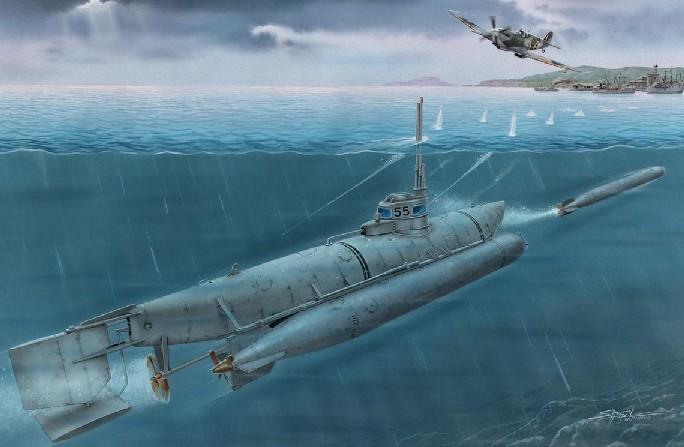
Special Hobby Ships 1/72 Special Navy Biber German Midget Submarine Kit
This Product Usually Ships In 3-4 Business Days
SHY-72006The Biber was one of the weapon systems developed during the Second World War at the time when the situation on both fronts was gradually becoming worse and worse for Germany. In 1943 it became clear that the Allied invasion would take place soon somewhere on the Atlantic coast of the continent and the German military began to seek and develop new and rather unorthodox weapons to avert the invasion. Along the Neger, Marder and Hai manned torpedoes, also the Biber and Molch midget submarines were to stop the invasion fleet.
The original idea of the Biber sub came from Korvettenkapitän Robert Bartels and first prototypes were built and the production took place at Flanderwerke in Lübeck, the development being led by Hermann Bunte. Allegedly, Bartels was influenced by captured British Welman W46 midget sub. The Biber’s displacement was 6.6 tonnes, on the surface it was powered by a 32 HP Otto Blitz petrol engine and while submerged, the propulsion was provided by a Siemens SSW GL231 electric motor. The Biber could submerge down to 20m, in an emergency to 30m. It could carry either two G7e torpedoes or mines. The hull was so diminutive that its operator (only a crew of one was possible) did not have much space in the conning tower.
The Biber prototype, known also as Adam, was put to tests on 29 March 1944, though the tests were not quite successful and several improvements had to be implemented before German Admiral Karl Dönitz approved building of further four prototype Bibers and later also the large-scale production, which gave a total of 324 Bibers from Flanderwerke, Ansaldo and Klökner-Humbolt-Deutz plants.
Bibers were put into so-called K-flottillen numbered 1 to 9, which saw action in the English Channel during the Allied invasion, in the North Sea off Norway, in the Scheldt estuary and also in the river Waal during the attack on the Nijmegen bridge. Bibers did not enjoy much success in the torpedo-carrying role, mine-laying missions suited them better. Some trouble also occurred due to the exhaust fumes getting into the operator’s station and many Bibers were lost just to this reason. The conning tower lacked in height causing the submarine pilot, who was equipped only with wrist compass, difficulties in finding his way to the target. Moreover, the Biber although being rather maneuverable and stable on the surface, was clumsy while under the water. Several Biber submarines were captured during the war, but the Allies did not seem to find interest in them and tested them only very briefly. Some of the surviving machines have been put on display in museums.
The Biber prototype, known also as Adam, was put to tests on 29 March 1944, though the tests were not quite successful and several improvements had to be implemented before German Admiral Karl Dönitz approved building of further four prototype Bibers and later also the large-scale production, which gave a total of 324 Bibers from Flanderwerke, Ansaldo and Klökner-Humbolt-Deutz plants.
Bibers were put into so-called K-flottillen numbered 1 to 9, which saw action in the English Channel during the Allied invasion, in the North Sea off Norway, in the Scheldt estuary and also in the river Waal during the attack on the Nijmegen bridge. Bibers did not enjoy much success in the torpedo-carrying role, mine-laying missions suited them better. Some trouble also occurred due to the exhaust fumes getting into the operator’s station and many Bibers were lost just to this reason. The conning tower lacked in height causing the submarine pilot, who was equipped only with wrist compass, difficulties in finding his way to the target. Moreover, the Biber although being rather maneuverable and stable on the surface, was clumsy while under the water. Several Biber submarines were captured during the war, but the Allies did not seem to find interest in them and tested them only very briefly. Some of the surviving machines have been put on display in museums.
- 3D designed and injection molded using metal molding blocks.
- The kit’s components come on two grey styrene sprues and one with clear parts. The A sprue offers the fuselage halves, B sprue has the torpedoes.
- The decal sheet brings markings for four overall grey Bibers and one bearing a camouflage scheme consisting of four colors. The latter and also one grey Biber were also decorated with a shark mouth. The rest of the machines in the kit have only numbers on the tower.











